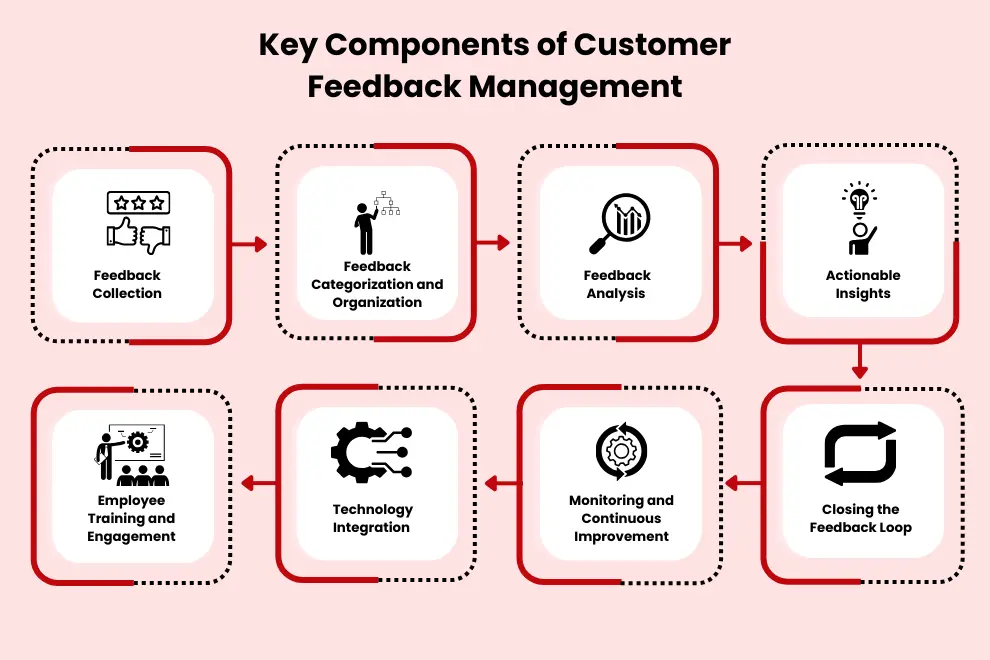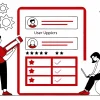
What Is Customer Feedback Management (CFM)?
Customer feedback management (CFM) involves collecting, analyzing, and using customer feedback to improve products, services, and customer experience. It involves the use of a customer feedback management system or feedback management software to efficiently capture, process, and utilize insights from customers. Effective customer feedback management is essential for staying responsive to customer needs and continuously enhancing the experience.
Why Is Customer Feedback Management Important?
Effective customer feedback management plays a pivotal role in shaping improvements across products and services. It provides valuable insights into customer satisfaction, areas for growth, and potential opportunities for innovation. Understanding why collecting customer feedback is important helps to enhance customer experiences, identify pain points, and prioritize areas that need attention.
By actively listening to customers, it becomes possible to increase satisfaction, improve retention, and promote better interactions over time. A well-structured customer feedback management process helps identify recurring issues, measure customer sentiment, and take proactive steps to address concerns, leading to increased customer trust and better outcomes.
Benefits of Customer Feedback Management
Customer feedback management offers numerous benefits that directly contribute to enhancing the overall customer experience, fostering loyalty, and driving continuous improvement. By properly managing customer feedback, individuals and organizations can unlock valuable insights that lead to positive outcomes. Below are some of the key benefits of effectively managing customer feedback:
1. Improved Customer Experience
One of the most significant benefits of customer feedback management is the ability to enhance the customer experience. When feedback is collected, analyzed, and acted upon, it helps identify pain points in the customer journey. This allows for targeted improvements, resulting in a more seamless and satisfying experience for customers.
2. Increased Customer Satisfaction and Loyalty
When customers see that their feedback is taken seriously and leads to tangible improvements, it builds trust and satisfaction. Regularly engaging with customers and acting on their input helps to cultivate loyalty, making them more likely to return and recommend services to others.
3. Better Decision-Making
Customer feedback provides critical insights that can guide decisions related to product development, service improvements, and strategy. By incorporating feedback into the decision-making process, more informed and effective choices can be made, leading to better outcomes.
4. Identification of Trends and Issues
Through consistent feedback management, it becomes easier to identify recurring themes, trends, and issues that customers face. Addressing these trends proactively can prevent bigger problems down the line and ensure continuous improvement in offerings.
5. Enhanced Innovation
Managing customer feedback encourages innovation by revealing new ideas and needs that customers may not have explicitly communicated otherwise. Feedback can uncover opportunities for new features, services, or enhancements, driving growth and innovation.
6. Competitive Advantage
In today’s fast-paced market, staying ahead of competitors is crucial. Customer feedback management helps you stay aligned with changing customer needs and market trends, giving you an edge over competitors who may not be as responsive to customer input.
7. Strengthened Customer Relationships
When customers feel heard and valued, their relationship with the brand or service deepens. Regular interaction through feedback shows customers that their opinions matter, which strengthens the bond and fosters a sense of community and trust.
How to Manage Customer Feedback?
Managing customer feedback requires a well-organized approach to ensure that valuable insights are properly gathered, analyzed, and utilized. The process includes several key steps, such as selecting the right feedback management software and continuously refining practices based on the feedback received.
The process typically involves:
- Setting up effective feedback collection channels
- Ensuring timely and accurate analysis of feedback data
- Acting on the insights gathered to make improvements
- Letting customers know what has been done in response to their feedback
Key Components of Customer Feedback Management

To fully implement a customer feedback strategy, it’s important to break the process into key components. Here are the main elements that contribute to effective customer feedback management:
1. Feedback Collection
The foundation of CFM lies in the process of collecting feedback. This involves gathering input from customers through various channels like surveys, social media, online reviews, chatbots, or email.
Effective feedback collection depends on using diverse methods to reach different segments of your audience. For instance, email surveys may work for one group, while social media polls could be more effective for another. Ensuring the questions are clear and focused on actionable insights is crucial.
2. Feedback Categorization and Organization
Not all feedback carries the same weight or urgency. Categorization ensures that businesses prioritize issues based on their impact, such as separating critical complaints from general suggestions or compliments.
By organizing feedback into categories—like service quality, product performance, or customer support—companies can allocate resources efficiently to address the most pressing concerns first.
3. Feedback Analysis
After collecting feedback, the next step is to analyze the data. This involves categorizing feedback into themes or topics, identifying patterns, and uncovering insights that reveal customer pain points or preferences.
Organizations can use tools like sentiment analysis, AI-driven feedback analysis software, or manual categorization to interpret the data. For example, analyzing recurring complaints about slow delivery times can highlight areas needing operational improvements.
4. Actionable Insights
Feedback is only valuable if it leads to actionable steps. Action planning involves taking the insights from feedback analysis and developing strategies to address customer concerns or enhance positive experiences.
For instance, if customers frequently highlight a need for more payment options, an action plan might involve integrating additional gateways. Effective action planning requires collaboration across departments, such as marketing, customer support, and operations.
5. Closing the Feedback Loop
One of the most critical yet often overlooked components is closing the feedback loop. This involves informing customers about the actions taken based on their feedback.
For example, if a customer suggests adding a feature to a product and it’s implemented, the company should communicate this update through an email or a social media announcement. Closing the loop not only builds trust but also encourages continued engagement.
6. Monitoring and Continuous Improvement
Customer preferences and market dynamics change over time, so CFM should be an ongoing process. Monitoring the effectiveness of implemented changes and regularly seeking feedback ensures that businesses stay aligned with customer expectations.
Regular audits, feedback cycles, and performance metrics like Net Promoter Scores (NPS) can help track progress and identify new areas for improvement.
7. Technology Integration
Modern CFM relies heavily on technology to streamline the process. Tools like Customer Relationship Management (CRM) software, survey platforms, and data analytics tools play a crucial role.
For example, CRM systems can centralize feedback data, while AI-powered analytics tools can provide real-time insights. Leveraging the right technology ensures scalability and efficiency in managing customer feedback.
8.Employee Training and Engagement
Employees must be equipped with the knowledge and skills to handle customer feedback effectively. Training programs should focus on active listening, empathetic communication, and conflict resolution.
Empowering teams ensures that they can address feedback constructively, turning negative experiences into positive outcomes and reinforcing customer loyalty.
Steps to Effectively Manage Customer Feedback Process
Simplifying the consumer feedback process is crucial for obtaining information and getting at accurate decisions. Below are the key steps to manage customer feedback effectively:
- Define Clear Objectives: Set clear goals for collecting feedback, such as improving satisfaction or evaluating experiences.
- Choose the Right Feedback Channels: Select the most appropriate methods for collecting feedback, such as surveys, reviews, or direct conversations.
- Analyze and Interpret the Data: Use feedback management software to analyze feedback and identify key trends or recurring issues.
- Take Action on Insights: Implement changes or improvements based on the feedback.
- Communicate Back to Customers: Let your audience know their feedback is valued and outline the steps taken based on their insights.
Best Practices for Effective Customer Feedback Management
To ensure customer feedback management is effective, follow best practices that promote engagement, accuracy, and actionable results:
1. Choose the Right Feedback Channels
Selecting the right feedback channels is essential for reaching a broad audience. Offering multiple feedback options, such as online surveys, social media polls, or in-person feedback forms, can ensure that a variety of opinions are captured.
2. Automate Feedback Collection
To save time and effort, automating feedback collection is highly effective. Using customer feedback management software or platforms that allow for seamless feedback requests and responses can streamline the process and ensure no valuable input is missed.
3. Prioritize Feedback Based on Impact
Not all feedback is equally urgent or impactful. Prioritize feedback based on its potential to influence key areas, such as improving experiences, resolving issues, or identifying new opportunities. Focus on feedback that can bring significant value.
4. Incorporate Feedback into Continuous Improvement
Feedback from customers shouldn’t be considered a one-time event. Incorporate feedback into ongoing continuous improvement processes to ensure consistent progress. This iterative process improves long-term happiness and helps keep alignment with consumer expectations.
5. Engage with Customers Regularly
Regular engagement with customers is crucial for understanding their evolving needs. By proactively seeking feedback at various stages, a deeper understanding of their experiences can be gained, fostering stronger relationships and trust.
How to Choose the Right Customer Feedback Management Tool?
Choosing the right customer feedback management tool is essential for effectively handling feedback. The ideal feedback management software should offer features like:
- An easy-to-use interface for collecting and analyzing feedback
- Integration with other tools (e.g., CRM, communication platforms)
- Automation capabilities to streamline feedback collection
- Real-time reporting and analytics to interpret customer sentiment
With tools like LazyMonkey, you can ensure a smooth, efficient feedback management process. LazyMonkey is designed to help businesses collect, analyze, and act on customer feedback with ease, offering seamless integration and automated workflows. Choosing the right tool, such as LazyMonkey, ensures that your feedback process is optimized for valuable insights and actionable outcomes.
Why wait? Upgrade to our customer feedback management software and achieve more, faster.
Conclusion
In conclusion, customer feedback management is an essential practice for improving customer experiences, understanding needs, and enhancing satisfaction. By effectively collecting and analyzing feedback, insights can be gained that lead to positive change. Using the right customer feedback management system, feedback management software, and a well-defined customer feedback strategy makes the feedback process efficient and valuable.
Whether through surveys, reviews, or conversations, managing customer feedback effectively allows for continuous improvement and alignment with customer needs. By following best practices and utilizing the right tools, the process becomes smoother, leading to better outcomes and more satisfied customers.
Frequently Asked Questions? (FAQs)
What Is Customer Feedback Management?
Customer feedback management (CFM) is the process of collecting, analyzing, and using feedback from customers to improve a business.
Why Is Customer Feedback Important?
Customer feedback helps businesses understand their customers’ needs, preferences, and pain points.
How Can Businesses Collect Customer Feedback?
Businesses can collect feedback through surveys, customer reviews, social media, direct interviews, and support tickets
How Often Should Businesses Gather Customer Feedback?
It depends on the business type, but regular feedback after major updates, purchases, or service interactions is recommended.
Enhance Patient Care and NABH Compliance with LazyMonkey
LazyMonkey is your all-in-one solution for improving patient care, retaining more patients, and meeting NABH standards. Our powerful QR-based feedback tool enables you to capture real-time insights from patient feedback, discharge surveys, staff and doctor evaluations, and clinical research, while also streamlining inter-departmental communication.
Transform your healthcare facility today - reach out to us at hello@lazymonkey.in, or request a demo here!
Elevate Your Restaurant Experience with LazyMonkey
LazyMonkey’s QR-based feedback system helps you gather real-time insights from customers, track satisfaction levels, and enhance the dining experience. Get instant feedback on your menu, service, and ambience, and make data-driven improvements to boost repeat customers and reviews.
Improve your restaurant today – reach out to us at hello@lazymonkey.in, or request a demo here!
Empower Student Engagement and Campus Improvement with LazyMonkey
LazyMonkey offers a seamless way to gather student feedback, track satisfaction, and enhance campus life. From course evaluations to dorm feedback, our QR-based solution makes it easy to capture valuable insights and improve student retention.
Upgrade your university experience – contact us at hello@lazymonkey.in, or request a demo here!
Streamline Feedback and Drive Performance Across Your Enterprise/Franchise with LazyMonkey
Whether you manage one or multiple locations, LazyMonkey’s QR-based feedback system helps you gather real-time employee and customer feedback. Improve operational efficiency, track satisfaction, and make data-driven decisions to enhance brand consistency and growth.
Transform your franchise today – reach out to us at hello@lazymonkey.in, or request a demo here!
Enhance Customer Satisfaction and Service Standards in Banking with LazyMonkey
LazyMonkey empowers banks to capture real-time feedback from clients across branches. Improve customer experience, assess service quality, and ensure regulatory compliance with our QR-based solution, helping you retain clients and meet banking standards.
Elevate your bank’s customer care – contact us at hello@lazymonkey.in, or request a demo here!
Boost Customer Engagement and Mall Satisfaction with LazyMonkey
LazyMonkey’s QR-based feedback tool enables you to collect feedback from shoppers, track satisfaction, and enhance the mall experience. Gather insights on store services, cleanliness, and entertainment to create an unmatched customer journey.














